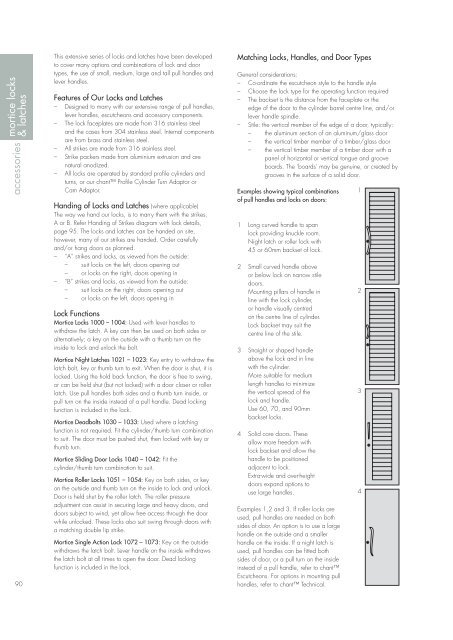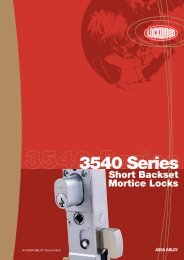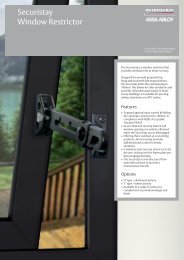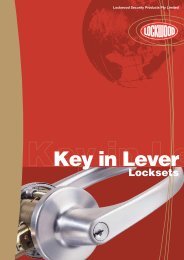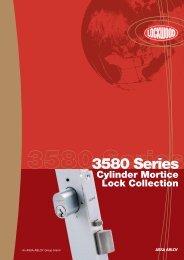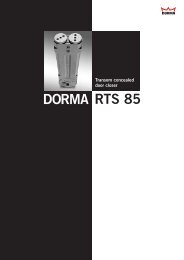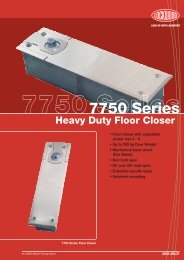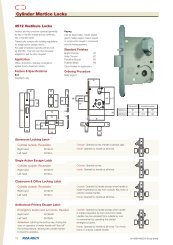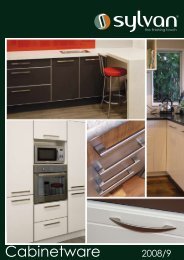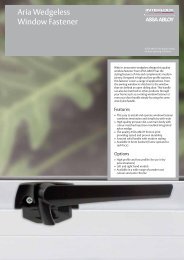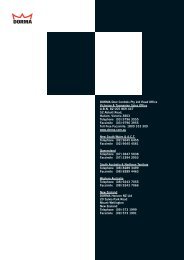PDF chant catalogue artwork.indd - Hardware Direct
PDF chant catalogue artwork.indd - Hardware Direct
PDF chant catalogue artwork.indd - Hardware Direct
You also want an ePaper? Increase the reach of your titles
YUMPU automatically turns print PDFs into web optimized ePapers that Google loves.
mortice locks<br />
& latches<br />
accessories<br />
90<br />
This extensive series of locks and latches have been developed<br />
to cover many options and combinations of lock and door<br />
types, the use of small, medium, large and tall pull handles and<br />
lever handles.<br />
Features of Our Locks and Latches<br />
– Designed to marry with our extensive range of pull handles,<br />
lever handles, escutcheons and accessory components.<br />
– The lock faceplates are made from 316 stainless steel<br />
and the cases from 304 stainless steel. Internal components<br />
are from brass and stainless steel.<br />
– All strikes are made from 316 stainless steel.<br />
– Strike packers made from aluminium extrusion and are<br />
natural anodized.<br />
– All locks are operated by standard profile cylinders and<br />
turns, or our <strong>chant</strong> Profile Cylinder Turn Adaptor or<br />
Cam Adaptor.<br />
Handing of Locks and Latches (where applicable)<br />
The way we hand our locks, is to marry them with the strikes,<br />
A or B. Refer Handing of Strikes diagram with lock details,<br />
page 95. The locks and latches can be handed on site,<br />
however, many of our strikes are handed. Order carefully<br />
and/or hang doors as planned.<br />
– “A” strikes and locks, as viewed from the outside:<br />
– suit locks on the left, doors opening out<br />
– or locks on the right, doors opening in<br />
– “B” strikes and locks, as viewed from the outside:<br />
– suit locks on the right, doors opening out<br />
– or locks on the left, doors opening in<br />
Lock Functions<br />
Mortice Locks 1000 – 1004: Used with lever handles to<br />
withdraw the latch. A key can then be used on both sides or<br />
alternatively; a key on the outside with a thumb turn on the<br />
inside to lock and unlock the bolt.<br />
Mortice Night Latches 1021 – 1023: Key entry to withdraw the<br />
latch bolt, key or thumb turn to exit. When the door is shut, it is<br />
locked. Using the hold back function, the door is free to swing,<br />
or can be held shut (but not locked) with a door closer or roller<br />
latch. Use pull handles both sides and a thumb turn inside, or<br />
pull turn on the inside instead of a pull handle. Dead locking<br />
function is included in the lock.<br />
Mortice Deadbolts 1030 – 1033: Used where a latching<br />
function is not required. Fit the cylinder/thumb turn combination<br />
to suit. The door must be pushed shut, then locked with key or<br />
thumb turn.<br />
Mortice Sliding Door Locks 1040 – 1042: Fit the<br />
cylinder/thumb turn combination to suit.<br />
Mortice Roller Locks 1051 – 1054: Key on both sides, or key<br />
on the outside and thumb turn on the inside to lock and unlock.<br />
Door is held shut by the roller latch. The roller pressure<br />
adjustment can assist in securing large and heavy doors, and<br />
doors subject to wind, yet allow free access through the door<br />
while unlocked. These locks also suit swing through doors with<br />
a matching double lip strike.<br />
Mortice Single Action Lock 1072 – 1073: Key on the outside<br />
withdraws the latch bolt. Lever handle on the inside withdraws<br />
the latch bolt at all times to open the door. Dead locking<br />
function is included in the lock.<br />
Matching Locks, Handles, and Door Types<br />
General considerations:<br />
– Co-ordinate the escutcheon style to the handle style<br />
– Choose the lock type for the operating function required<br />
– The backset is the distance from the faceplate or the<br />
edge of the door to the cylinder barrel centre line, and/or<br />
lever handle spindle.<br />
– Stile: the vertical member of the edge of a door, typically:<br />
– the aluminum section of an aluminum/glass door<br />
– the vertical timber member of a timber/glass door<br />
– the vertical timber member of a timber door with a<br />
panel of horizontal or vertical tongue and groove<br />
boards. The ‘boards’ may be genuine, or created by<br />
grooves in the surface of a solid door.<br />
Examples showing typical combinations<br />
of pull handles and locks on doors:<br />
1 Long curved handle to span<br />
lock providing knuckle room.<br />
Night latch or roller lock with<br />
45 or 60mm backset of lock.<br />
2 Small curved handle above<br />
or below lock on narrow stile<br />
doors.<br />
Mounting pillars of handle in<br />
line with the lock cylinder,<br />
or handle visually centred<br />
on the centre line of cylinder.<br />
Lock backset may suit the<br />
centre line of the stile.<br />
3 Straight or shaped handle<br />
above the lock and in line<br />
with the cylinder.<br />
More suitable for medium<br />
length handles to minimize<br />
the vertical spread of the<br />
lock and handle.<br />
Use 60, 70, and 90mm<br />
backset locks.<br />
4 Solid core doors. These<br />
allow more freedom with<br />
lock backset and allow the<br />
handle to be positioned<br />
adjacent to lock.<br />
Extra-wide and over-height<br />
doors expand options to<br />
use large handles.<br />
Examples 1,2 and 3. If roller locks are<br />
used, pull handles are needed on both<br />
sides of door. An option is to use a large<br />
handle on the outside and a smaller<br />
handle on the inside. If a night latch is<br />
used, pull handles can be fitted both<br />
sides of door, or a pull turn on the inside<br />
instead of a pull handle, refer to <strong>chant</strong><br />
Escutcheons. For options in mounting pull<br />
handles, refer to <strong>chant</strong> Technical.<br />
1<br />
2<br />
3<br />
4


